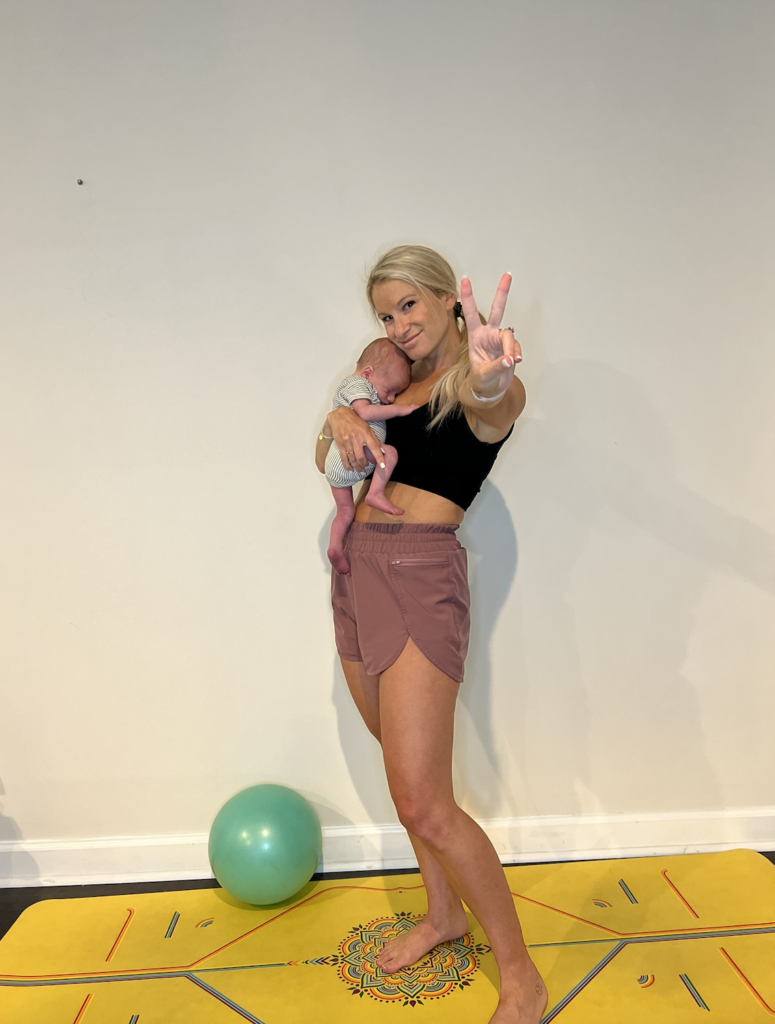What Is the FIRST things You Should Be Focusing On
After Giving Birth?
Whether you just gave birth, just had been cleared at the doctor at your 6 week appointment, or have just not had the knowledge or motivation to workout after having the baby, starting with rebuilding your core and pelvic floor strength is KEY. Rebuilding connection with low core and pelvic floor after trauma is VITAL in order to fully heal and recover. Although your mind may be ready to GO, your body is not yet ready and it’s important to take your time with these rehab movements This phase is not a time for long duration or high frequency workouts, but rather general movement patterns.

4 Exercises To Utilize During
Early Postpartum:
1. 360 Diaphragmatic Breathing
Diaphragmatic breathing is a relationship between the diaphragm and the pelvic floor, where they work together to adjust pressure within the abdominal cavity. It’s also a way we manage pressure in our abdominal cavities, especially because it:
✔️Stabilizes the spine
✔️Supports and enhances functional movement
✔️Counters increases in pressure from exertion
✔️Supports a more effective pushing phase during birth
🫁As you INHALE: your diaphragm moves down, as your abs, the back, and the pelvic floor all lengthen and stretch.
– inhale through your “holes”, inhale through your lats, open an umbrella in your ribcage, inhale with a soft smile, breathe in wide
😮💨As you EXHALE, your e diaphragm relaxes and moves upward, pushing your air out of your lungs, which increases your pressure inside your abdominal cavity slightly.
– exhale as you squeeze your hip bones together, exhale as you close your ribs
- Supine (on back)
- Table top (on all 4's)
- Side Lying (on side)
- Seated (on ball or floor)
- You can also add in a ball for some external feedback during this exercise (like shown above!)
2. Low Core/Tva exerices
The transverse abdominals (or TVA) are your deep core muscles that go around your hips and connect to your pelvic floor, basically where you would your strap a seat belt around your waist. Learning to both relax & strengthen by coordinating your transverse abdominals and your pelvic floor is crucial for postpartum recovery because of the trauma that has happened to your pelvic floor from growing and birthing a baby, no matter what method was used to get baby out safely. Because your pelvic floor is weakened, these low core muscles must be strengthened in order to support your pelvic organs such as your uterus, bladder, and rectum, and provide stability to your pelvic floor overall. These muscles also utilize the same nerve roots, so as you activate your TVA, your pelvic floor activates in conjunction as well and vice versa. Because they also support the lumbar spine, when we don’t utilize these low core muscles and repair postpartum, many ailments and complications can occur such as low back pain, pelvic pain, urinary incontinence, pelvic organ prolapse, and other issues. Incorporating these exercises into your routine as soon as you feel ready to postpartum is key, and even if you’re years postpartum and haven’t fully repaired the strength of your TVA, it’s never too late to start!
- Birddog Variations
- Deadbug Variations
- Heel Slides
- Pelvic Tilts
- && more incorporated in my Strong As A Mother Program!
3. Roll In/out Variations
Roll in/out variations using a superband are very helpful for activating and strengthening your pelvic floor, especially after having a baby and trauma from the pelvic floor. By internally and externally rotating your leg initiated from the femur bone, your body is learning to coordinate the pelvic floor and strengthen each outlet of the pelvis to help with recovery.
I find that placing my finger(s) on the hip socket where my leg meets my hip to ensure the movement is initiated from the femur bone and not the foot is very helpful for these variations (watch videos to see where my fingers lie!).
- Supine (lying down with legs in air)
- Seated (legs extended)
- Modified Side Plank (top leg rotates)
- Side Lying (top leg rotates)
- Remember to initiate movement from femur bone or hip socket!
4. Thoracic & Lumbar Spine Mobility
It’s no surprise to new mamas that back pain may start to take over because of the great amount of postural changes that take place in order to keep babe healthy and alive, such as feeding, rocking, picking up, and other movements that involve “hunching over” can place a lot of tension in our backs. We need to make room in our ribcages and upper body to rotate, especially now that babe is out of the way. In order to full activate and strengthen our low core & pelvic floor, we need thoracic mobility to allow them to fully function properly and as a whole unit. It’s also what supports our diaphragm and lungs, so if it’s not mobilized, you won’t be able to properly perform 360 diaphragmatic breathing, as well as many of the above exercises, so it’s crucial to include in your routine early postpartum to ensure neuromuscular connection & coordination for healing & repair.
- Supine T-Spine Rotations (video)
- Quadruped (all 4's) T-Spine Rotation
- Banded Standing Thoracic Rotations
- Forward fold alternating twists
- Downdog to Easy Twist